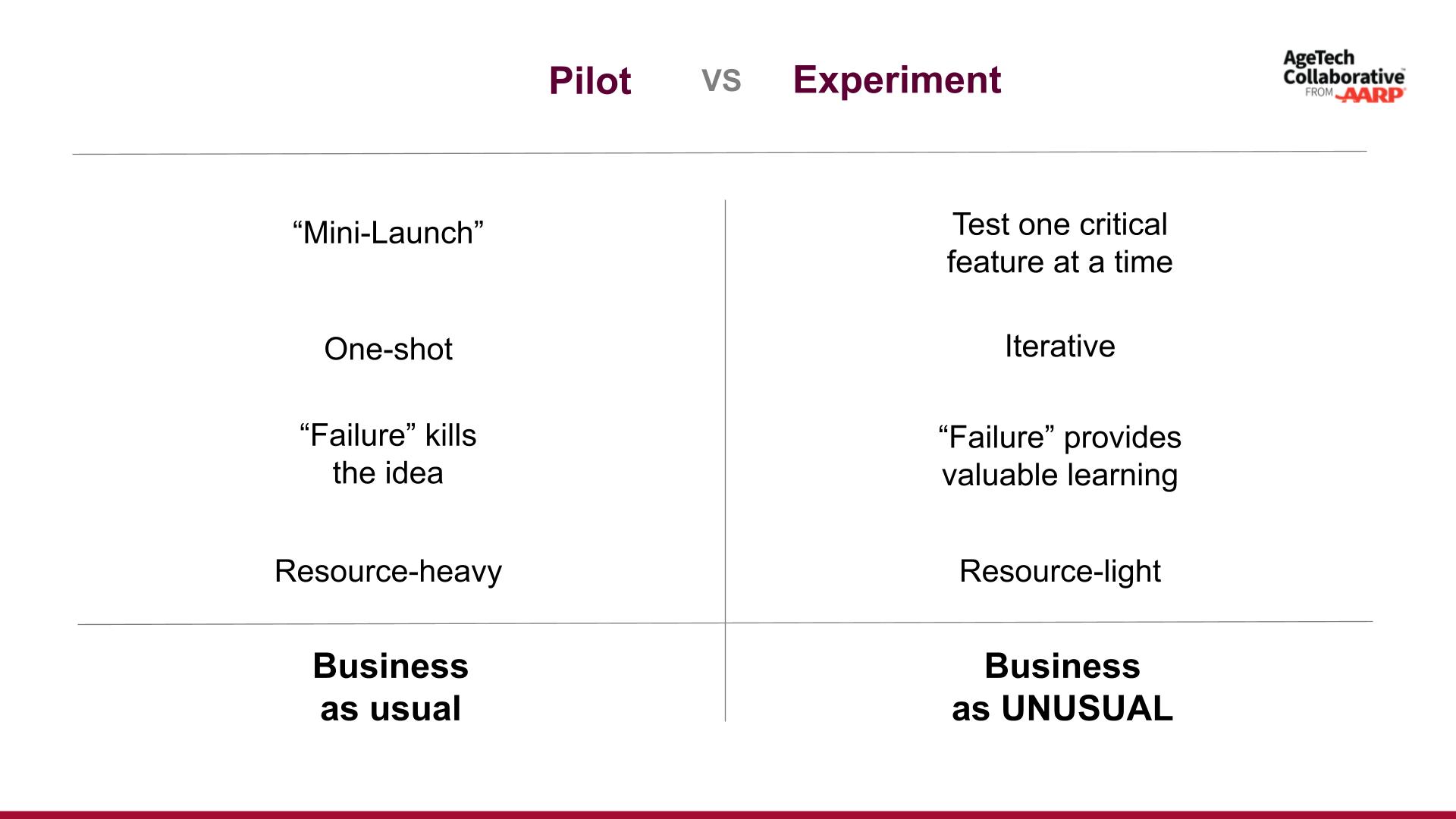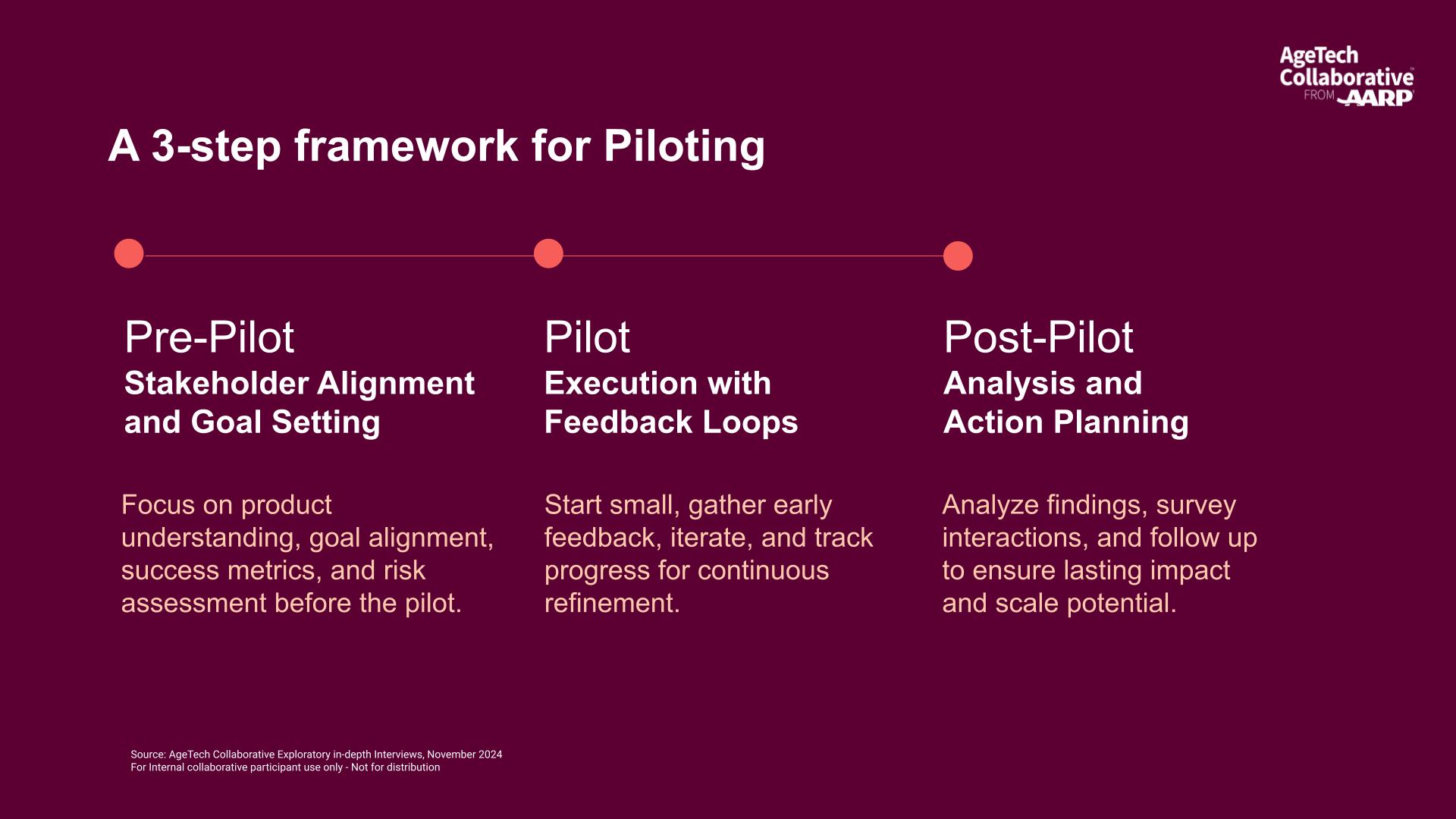Effective Pilot Planning: Strategies for Success
By Deborah Jordan and Mrunal Aras
May 2025
About the Report
As a startup founder, the only way to know if a product or service actually has a chance to succeed is to test it in the real world. In-market pilots serve as a means to validate and scale startup solutions. Pilots can stress-test a product or service and help it to gain credibility. In addition, the pilot can be crucial for providing access to a particular target market and/or the clients who’ll ultimately buy the product.
Many of the startups in the AgeTech Collaborative™ from AARP have come up with innovative solutions to empower adults 50-plus as they face the challenges ahead. Some of their products are geared towards helping these consumers manage their healthcare, finances, or other aspects of their lives; others help those who care for these individuals to provide better service. Either way, pilots for tech startups are increasingly important as the market expands—it’s projected to reach a staggering $2 trillion in the coming years. As such, the industry is poised to redefine how consumers over age 50 experience aging, and startups that manage to secure funding as a result of a successful in-market pilot have a huge competitive advantage.
This report will discuss the purpose of a pilot and will share valuable insights from startup founders on their pilot programs. It will also introduce a three-step framework for piloting culled from industry best practices and multiple interviews with experienced startup founders and senior living decisionmakers.
The Purpose of a Pilot
A pilot study is defined as “a small-scale test of the methods and procedures to be used on a larger scale.” The goal of pilot work is not to test hypotheses about the effects of an intervention, but rather, to assess the feasibility/acceptability of an approach to be used in a larger scale study,” according to NIH.
An in-market pilot provides a unique opportunity to validate a solution in a real-world setting, gaining insights into both its strengths and areas for refinement. In the AgeTech market, this often means testing within environments like continuing care retirement communities (CCRCs), senior living facilities, hospitals, or home care settings, where adoption and impact can be assessed in context. These institutions act as “testbeds,” provide valuable feedback from end users, caregivers, and administrators, helping to refine the solution before broader deployment.
“A pilot is a chance for the startup to be able to prove themselves and their product and their team to the larger test bed organization as well as get a sense of what it’s like to work with that larger organization so that you can find better success in a larger rollout.”– James Li, Mighty Health, AgeTech Collaborative Portfolio Startup
For example, GaitBetter, an AgeTech Collaborative portfolio startup, partnered with the Army Distaff Foundation, an AgeTech Collaborative testbed, to pilot its gait rehabilitation and fall prevention technology. The 5-month study aimed to assess cost-effectiveness, health impact, and resident engagement. Through this pilot, GaitBetter has helped residents regain independence while also refining its product based on real-world insights. Similarly, Zinnia, a dementia support platform, partnered with Maplewood Senior Living to enhance memory care. After a successful pilot, Maplewood is now rolling out Zinnia’s technology across its 16 communities to create a calming environment and reduce agitation for residents.
The many potential benefits of a pilot program include the following:
-
- An opportunity to validate and scale a solution – As a means of Proof of Concept (POC), a pilot can bring a startup to another level. A POC shows that a startup’s solution is viable, scalable, and capable of delivering added value to customers.
- A chance to stress-test a solution – Pilots can provide feedback and insights from pilot participants, which a startup can then use to rethink or reiterate a product or service’s value proposition.
- The means to gain product/service credibility – A pilot provides the opportunity to see a startup’s value proposition in action. This, in turn, can help build trust and credibility that ultimately will translate into customer attraction, increased market share, or possibly entering new markets.
- A chance to showcase the startup to stakeholders and consumers – Pilots are a great way to validate a value proposition with real customers in a controlled environment and to get valuable feedback that could help to improve the offering and, in some cases, create new business verticals.
Pilots vs. Experiments: When to Employ Each
While an in-market pilot is a test of a nearly complete product in the real world, an experiment is a more controlled study used to gather specific data about a particular aspect of a product or concept. Typically, the focus of an experiment is on learning, not immediate market implementation (see Figure 1 below).
For example, one of the AgeTech Collaborative startups, focused on document management and organization, aimed to optimize their product for caregivers. They wanted to redesign how information categories were structured, making assumptions about caregiver priorities. To ensure the design was intuitive, they conducted user testing and made quick iterations based on feedback.
Experiments are low risk, and they can be a great way to identify weaknesses in any existing data. Before experimenting, it’s important to create a test framework that outlines the following:
-
- Any aims or objectives
- The methodology
- What specific data the startup is trying to collect
- Whether the test is exploratory or aiming to answer a specific question or hypothesis
When testing is completed, the participating startup should be able to pull together all the information and produce an up-to-date, field-tested service offering document that outlines its idea in depth, with any changes as a result of testing included.
Figure 1: Pilot vs. Experiment

Channels to Secure a Pilot
The best way to secure pilot opportunities is to engage with potential customers or partners in a strategic and proactive way.
While pilots can be highly beneficial for a startup, the securing of pilots, particularly with larger businesses and organizations, can be challenging. Instead of focusing on large organizations, startups also can consider Small and Medium Business (SMBs) and other strategic companies or organizations. By doing this, they could reduce the bureaucracy and complexity in securing pilots due to a streamlined procurement process and a greater appetite for innovation.
With the help of resources, such as the AgeTech Collaborative from AARP, startups can keep a close eye on accelerator programs, incubators, or innovation hubs that provide access to enterprise partners and potential pilot opportunities. These programs often offer mentorship, resources, and networking opportunities to help validate a startup’s value proposition and confirm product market fit.
Government contracts may also be worth exploring. The startup ecosystem has evolved over the years and governments have played a key role in this evolution.
There are opportunities to secure government contracts, grants, or research funding that may allow a startup to develop and pilot its solution with government agencies or public sector organizations. No matter which avenue a startup chooses, the end result should be to collect as much feedback about its product or service as possible in the allotted timeframe, so that the business can continue to improve upon the initial concept and ensure that its product or service is delivering on its promise. Oftentimes, pilot participants will be willing to offer feedback on a product or service—particularly if its purpose is to improve one or more aspects of their lives.
Creating a Framework for a Pilot Program
The AgeTech Collaborative built a pilot planning framework based on industry best practices, insights from expert interviews, and firsthand experience working with startups. The three steps identified are Stakeholder Alignment and Goal-Setting, Execution with Feedback Loops, and Analysis and Action Planning. The first step takes place pre-pilot, the second during the pilot, and the third post-pilot (see Figure 2 below).
Figure 2: A 3-Step Framework for Piloting

During Step 1 (Stakeholder Alignment and Goal-Setting), a startup should focus on product understanding, goal alignment, success metrics, and risk assessment before the pilot. Remember, meticulous preparation is a must to both ensure success and get the most out of the pilot.
“The two biggest drivers tend to be: Are we making more money with your product, or are we saving money with your product? You know, even in a situation where people are very altruistic, they’re still running a business, and they need to make sure that it makes sense to spend money on something like this.”—Sidney Collins, De Oro Devices, AgeTech Collaborative Portfolio Startup
During Step 2 (Execution with Feedback Loops), a startup needs to start small, gather early feedback, iterate, and track progress for continuous refinement. Tracking and monitoring is essential so startups are aware of what’s happening with their end users, key stakeholders, their support staff, and the entities’ support staff to anticipate any challenges and remain proactive.
“We try to get testimonials from all the people that used [our device], to gain an understanding of their experience. We can share that with the team. So it’s not just data. It’s this real person with a real experience. We also get quotes from the staff who’s using it so that then we can go to the C-suite and say, ‘Look, this is what your head of Rehab said about the product.”—Sidney Collins, De Oro Devices, AgeTech Collaborative Portfolio Startup
During Step 3 (Analysis and Action Planning), a startup should analyze findings, survey interactions, and follow up to ensure lasting impact and scale potential. These learnings can drive success going forward and could have implications for every aspect of a startup’s business, such as the product, specs, business model, and customer support.
“Follow up with members to foster engagement. Also, follow up with these participants to stick out from the crowd of startup pitches. Even in-person follow-up visits.”—James Li, Mighty Health, AgeTech Collaborative Portfolio Startup
“Our residents are really excited to be engaged with something new. And so they’re really eager to learn more about technology too…… If the feedback they can provide could help somebody else….they feel really called to engage in that as well.”—Jesse Riley, Holland Home, AgeTechCollaborative Testbed
To ensure a successful pilot, it is essential to curate a well-structured workflow and define all key elements of the pre-pilot stage. Recognizing this need, the Collaborative’s Design Thinking Practice developed the Stakeholder Alignment Tool to support startups in structuring their planning process. This simple yet effective tool helps teams identify the key questions to ask at the outset of a pilot. While not all answers may be available immediately, the tool serves as a roadmap for gathering critical information, guiding discussions with project sponsors, and increasing awareness of unresolved questions that could impact the pilot’s success.
The Stakeholder Alignment Tool, as well as a detailed guide to the 3-step pilot planning framework, including best practices, is available for download exclusively to AgeTech Collaborative participants. Learn more about becoming a participant in the AgeTech Collaborative and how to apply.
Conclusion
How a startup ultimately stands out from the crowd of businesses hoping to secure pilot partners—and, eventually, funding—is by going the extra mile when it comes to making sure all stakeholders understand the purpose of the product or service, aligning on the mutual key metrics and being present to address questions or help work through any issues during the pilot phase. Once the pilot program concludes, it’s also important to maintain a presence and keep all stakeholders apprised of any data or other findings. Employing the 3-step framework discussed in this report will allow startups to seamlessly prepare, execute, and follow up on the pilot program, increasing their odds for success in a competitive marketplace.
